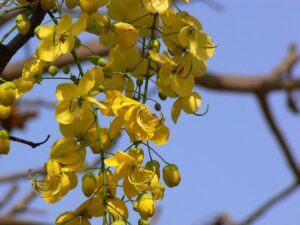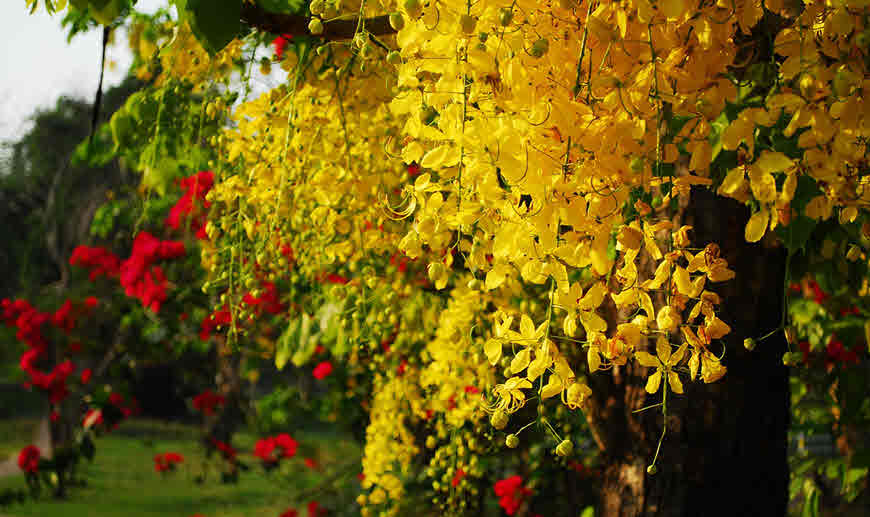Herb
Aragvadha (Cassia fistula) Herb Ayurvedic Overview
Aragvadha (Cassia fistula) is a Sanskrit word which defines as the elimination of diseases. It consists of pulp obtained from fruits (devoid of seeds, septa, and pieces of pericarp) of Cassia fistula Linn. (Fam. Leguminosae). It is a moderate-sized deciduous tree, common throughout India as a wild or cultivated plant, and fruits are collected when they are ripe. Aragvadha (Cassia fistula) tree grows up to 20 feet to 35 feet with a straight trunk. The bark is greenish-grey when young, slightly reddish, and rough when old. Aragvadha fruits are cylindrical pods, brownish-black. approx 30 to 45 cm long and 2 to 3 cm in diameter. The seeds are flat, smooth, testa very hard, numerous, present between the pulp.
The Pharmacological action of Aragvadha (Cassia fistula) is Anti-inflammatory, Antipyretic, Analgesic, Antiviral, Antibacterial, Antifungal, Hepatoprotective, hypoglycemic and Antioxidant. Aragvadha (Cassia fistula) is easily found in the Indian subcontinent and associated regions of South East Asia. It is mainly found in Myanmar, Sri Lanka, Thailand, and in India Aragvadha (Cassia fistula) is easily available in Tamil Nadu, and Kerala.
Each part of Aragvadha (Cassia fistula) plant has therapeutic as well as curative value. The fruit pulp is mainly used for medicinal purposes and to heal wounds. The leaves are used for the preparation of ointments, creams, and poultices. The bark has potent astringent-like properties and used for relieving acute to chronic inflammatory condition, whereas the wood is highly durable and used in the manufacturing and furniture industries.
Table of Contents
Scientific Classification of Aragvadha (Cassia fistula):
- Kingdom: Plantae
- Order: Fabales
- Family: Fabaceae
- Genus: Cassia
- Species: C. fistula
Aragvadha (Cassia fistula) Synonyms:
- Sanskrit: Krtamala, Vyadhighata, Sampaka, Nrpadruma
- Assamese: Sonaroo
- Bengali: Sondala
- English: Indian Laburnum, Purging cassia
- Gujrati: Garamala, Garamalo
- Hindi: Amaltas
- Kannada: Aragvadha, Kakke, Kakke-gida, Kakkemara, Kakkedai
- Kashmiri: Kriyangal Phali
- Malayalam: Konna, Kritamalam
- Marathi: Bahava, Garamala, Amaltas
- Oriya: Sunari
- Punjabi: Amaltas
- Tamil: Sarakonrai, Sarakkonnai, Sarakkondi, Sharakkonrai
- Telugu: Rela
- Urdu: Khiyar Shambar
 Aragvadha (Cassia fistula) Description:
Aragvadha (Cassia fistula) Description:
a) Macroscopic: Fruit is an indehiscent pod that is 35-60 cm long and 18-25 mm diameter, nearly straight and subcylindrical, chocolate-brown to almost black. The pod surface is smooth to the naked eye, but it shows minute transverse fissures present in both dorsal and ventral sutures under a lens. The short stalk is attached to the base of fruit and rounded distal end mucronate, pericarp thin, complex, and woody. The fruit is initially divided by transverse septa, which are approximately 5 mm in size, apart, each containing a single seed which attached to a ventral suture by a dark-colored thread-like funicle having about 6-8 mm, circular to oval, flattened, smooth, reddish-brown color, and extremely hard.
A distinct dark brown line extends from micropyle to base, seed initially embedded in a black viscid pulp 12 consisting of a thin, black, shining, circular disc. When it is dipped in water, it makes a yellow solution which darkness to brownish-yellow to dark brown. The seeds are often lye loose in their segments, odor faint, sickly, taste, and sweet.
Identity, Purity, and Strength of Aragvadha (Cassia fistula):
- Foreign matter Not more than 2 percent, Appendix 2.2.2.
- Total Ash Not more than 6 percent, Appendix 2.2.3.
- Acid-insoluble ash Not more than 1 percent, Appendix 2.2.4.
- Alcohol-soluble extractive Not less than 15 percent, Appendix 2.2.6.
- Water-soluble extractive Not less than 46 percent, Appendix 2.7.
Chemical Constituents of Aragvadha (Cassia fistula):
Sugar, mucilage, pectin, and anthraquinone, and the pulp of the pod contains glycosides, sennosides A and B, rhein and its glucoside, barbaloin, Rheinglucoside, Emodin, Chrysophanic Acid, Phlobaphenes, Fistuacacidin, Lupeol, and Sterols like Beta-Sitosterol, and Hexacosanol.
Ayurvedic Properties and Action of Aragvadha (Cassia fistula):
- Rasa: Madhura, Tikta
- Guna: Guru
- Virya: Ushna
- Vipaka: Madhura
- Karma: Rechana, Pittakaphahara, gudaroga, Udara, Vrana, Kusta, Amavata, Gandamala, Krimi, Udarashoola, Prameha.
Ayurvedic Formulation made by Aragvadha (Cassia fistula):
Aragvadhadi Kwath Churna, Aragvadhadyarishta, Aragvadhadi kashayam, Maha Manjistadi kashayam, Aragvadhamahaatiktaka grrutam, Aragwadhamrutaadi Kashayam.
Therapeutic Uses of Aragvadha (Cassia fistula):
The main therapeutic uses of Aragvadha are: Vibandha, Udavarta, Gulma, Shoola, Udararoga, Hridroga, Prameha,
Dose of Aragvadha (Cassia fistula):
3-5 gm of the drug in powder form.
Reference:
Ayurvedic Pharmacopeia of India.
For regular health updates, please follow our Social Pages


